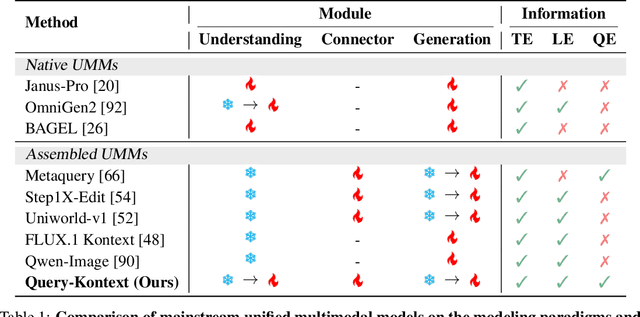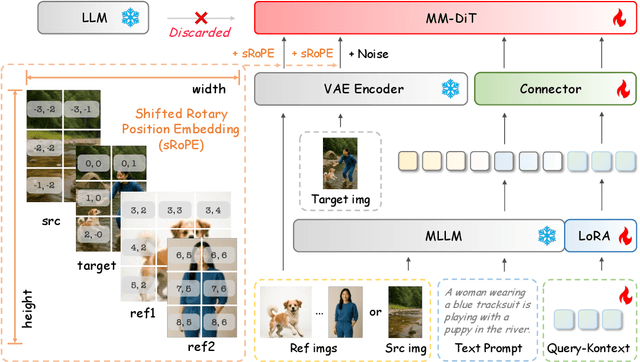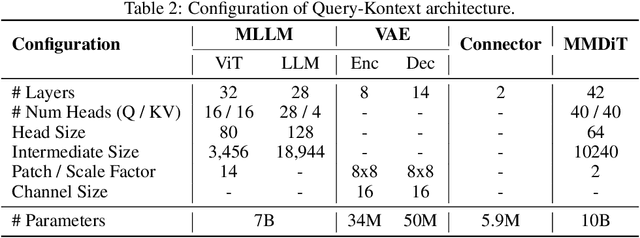Qi Zhang
School of Information, North China University of Technology
Counteracting Matthew Effect in Self-Improvement of LVLMs through Head-Tail Re-balancing
Oct 30, 2025Abstract:Self-improvement has emerged as a mainstream paradigm for advancing the reasoning capabilities of large vision-language models (LVLMs), where models explore and learn from successful trajectories iteratively. However, we identify a critical issue during this process: the model excels at generating high-quality trajectories for simple queries (i.e., head data) but struggles with more complex ones (i.e., tail data). This leads to an imbalanced optimization that drives the model to prioritize simple reasoning skills, while hindering its ability to tackle more complex reasoning tasks. Over iterations, this imbalance becomes increasingly pronounced--a dynamic we term the "Matthew effect"--which ultimately hinders further model improvement and leads to performance bottlenecks. To counteract this challenge, we introduce four efficient strategies from two perspectives: distribution-reshaping and trajectory-resampling, to achieve head-tail re-balancing during the exploration-and-learning self-improvement process. Extensive experiments on Qwen2-VL-7B-Instruct and InternVL2.5-4B models across visual reasoning tasks demonstrate that our methods consistently improve visual reasoning capabilities, outperforming vanilla self-improvement by 3.86 points on average.
GTR-Mamba: Geometry-to-Tangent Routing for Hyperbolic POI Recommendation
Oct 27, 2025Abstract:Next Point-of-Interest (POI) recommendation is a critical task in modern Location-Based Social Networks (LBSNs), aiming to model the complex decision-making process of human mobility to provide personalized recommendations for a user's next check-in location. Existing POI recommendation models, predominantly based on Graph Neural Networks and sequential models, have been extensively studied. However, these models face a fundamental limitation: they struggle to simultaneously capture the inherent hierarchical structure of spatial choices and the dynamics and irregular shifts of user-specific temporal contexts. To overcome this limitation, we propose GTR-Mamba, a novel framework for cross-manifold conditioning and routing. GTR-Mamba leverages the distinct advantages of different mathematical spaces for different tasks: it models the static, tree-like preference hierarchies in hyperbolic geometry, while routing the dynamic sequence updates to a novel Mamba layer in the computationally stable and efficient Euclidean tangent space. This process is coordinated by a cross-manifold channel that fuses spatio-temporal information to explicitly steer the State Space Model (SSM), enabling flexible adaptation to contextual changes. Extensive experiments on three real-world datasets demonstrate that GTR-Mamba consistently outperforms state-of-the-art baseline models in next POI recommendation.
Metacognitive Self-Correction for Multi-Agent System via Prototype-Guided Next-Execution Reconstruction
Oct 16, 2025Abstract:Large Language Model based multi-agent systems (MAS) excel at collaborative problem solving but remain brittle to cascading errors: a single faulty step can propagate across agents and disrupt the trajectory. In this paper, we present MASC, a metacognitive framework that endows MAS with real-time, unsupervised, step-level error detection and self-correction. MASC rethinks detection as history-conditioned anomaly scoring via two complementary designs: (1) Next-Execution Reconstruction, which predicts the embedding of the next step from the query and interaction history to capture causal consistency, and (2) Prototype-Guided Enhancement, which learns a prototype prior over normal-step embeddings and uses it to stabilize reconstruction and anomaly scoring under sparse context (e.g., early steps). When an anomaly step is flagged, MASC triggers a correction agent to revise the acting agent's output before information flows downstream. On the Who&When benchmark, MASC consistently outperforms all baselines, improving step-level error detection by up to 8.47% AUC-ROC ; When plugged into diverse MAS frameworks, it delivers consistent end-to-end gains across architectures, confirming that our metacognitive monitoring and targeted correction can mitigate error propagation with minimal overhead.
From Scores to Preferences: Redefining MOS Benchmarking for Speech Quality Reward Modeling
Oct 01, 2025Abstract:Assessing the perceptual quality of synthetic speech is crucial for guiding the development and refinement of speech generation models. However, it has traditionally relied on human subjective ratings such as the Mean Opinion Score (MOS), which depend on manual annotations and often suffer from inconsistent rating standards and poor reproducibility. To address these limitations, we introduce MOS-RMBench, a unified benchmark that reformulates diverse MOS datasets into a preference-comparison setting, enabling rigorous evaluation across different datasets. Building on MOS-RMBench, we systematically construct and evaluate three paradigms for reward modeling: scalar reward models, semi-scalar reward models, and generative reward models (GRMs). Our experiments reveal three key findings: (1) scalar models achieve the strongest overall performance, consistently exceeding 74% accuracy; (2) most models perform considerably worse on synthetic speech than on human speech; and (3) all models struggle on pairs with very small MOS differences. To improve performance on these challenging pairs, we propose a MOS-aware GRM that incorporates an MOS-difference-based reward function, enabling the model to adaptively scale rewards according to the difficulty of each sample pair. Experimental results show that the MOS-aware GRM significantly improves fine-grained quality discrimination and narrows the gap with scalar models on the most challenging cases. We hope this work will establish both a benchmark and a methodological framework to foster more rigorous and scalable research in automatic speech quality assessment.
Query-Kontext: An Unified Multimodal Model for Image Generation and Editing
Sep 30, 2025



Abstract:Unified Multimodal Models (UMMs) have demonstrated remarkable performance in text-to-image generation (T2I) and editing (TI2I), whether instantiated as assembled unified frameworks which couple powerful vision-language model (VLM) with diffusion-based generator, or as naive Unified Multimodal Models with an early fusion of understanding and generation modalities. We contend that in current unified frameworks, the crucial capability of multimodal generative reasoning which encompasses instruction understanding, grounding, and image referring for identity preservation and faithful reconstruction, is intrinsically entangled with high-fidelity synthesis. In this work, we introduce Query-Kontext, a novel approach that bridges the VLM and diffusion model via a multimodal ``kontext'' composed of semantic cues and coarse-grained image conditions encoded from multimodal inputs. This design delegates the complex ability of multimodal generative reasoning to powerful VLM while reserving diffusion model's role for high-quality visual synthesis. To achieve this, we propose a three-stage progressive training strategy. First, we connect the VLM to a lightweight diffusion head via multimodal kontext tokens to unleash the VLM's generative reasoning ability. Second, we scale this head to a large, pre-trained diffusion model to enhance visual detail and realism. Finally, we introduce a low-level image encoder to improve image fidelity and perform instruction tuning on downstream tasks. Furthermore, we build a comprehensive data pipeline integrating real, synthetic, and open-source datasets, covering diverse multimodal reference-to-image scenarios, including image generation, instruction-driven editing, customized generation, and multi-subject composition. Experiments show that our approach matches strong unified baselines and even outperforms task-specific state-of-the-art methods in several cases.
MDAR: A Multi-scene Dynamic Audio Reasoning Benchmark
Sep 26, 2025Abstract:The ability to reason from audio, including speech, paralinguistic cues, environmental sounds, and music, is essential for AI agents to interact effectively in real-world scenarios. Existing benchmarks mainly focus on static or single-scene settings and do not fully capture scenarios where multiple speakers, unfolding events, and heterogeneous audio sources interact. To address these challenges, we introduce MDAR, a benchmark for evaluating models on complex, multi-scene, and dynamically evolving audio reasoning tasks. MDAR comprises 3,000 carefully curated question-answer pairs linked to diverse audio clips, covering five categories of complex reasoning and spanning three question types. We benchmark 26 state-of-the-art audio language models on MDAR and observe that they exhibit limitations in complex reasoning tasks. On single-choice questions, Qwen2.5-Omni (open-source) achieves 76.67% accuracy, whereas GPT-4o Audio (closed-source) reaches 68.47%; however, GPT-4o Audio substantially outperforms Qwen2.5-Omni on the more challenging multiple-choice and open-ended tasks. Across all three question types, no model achieves 80% performance. These findings underscore the unique challenges posed by MDAR and its value as a benchmark for advancing audio reasoning research.Code and benchmark can be found at https://github.com/luckyerr/MDAR.
A Vision-Language-Action-Critic Model for Robotic Real-World Reinforcement Learning
Sep 19, 2025Abstract:Robotic real-world reinforcement learning (RL) with vision-language-action (VLA) models is bottlenecked by sparse, handcrafted rewards and inefficient exploration. We introduce VLAC, a general process reward model built upon InternVL and trained on large scale heterogeneous datasets. Given pairwise observations and a language goal, it outputs dense progress delta and done signal, eliminating task-specific reward engineering, and supports one-shot in-context transfer to unseen tasks and environments. VLAC is trained on vision-language datasets to strengthen perception, dialogic and reasoning capabilities, together with robot and human trajectories data that ground action generation and progress estimation, and additionally strengthened to reject irrelevant prompts as well as detect regression or stagnation by constructing large numbers of negative and semantically mismatched samples. With prompt control, a single VLAC model alternately generating reward and action tokens, unifying critic and policy. Deployed inside an asynchronous real-world RL loop, we layer a graded human-in-the-loop protocol (offline demonstration replay, return and explore, human guided explore) that accelerates exploration and stabilizes early learning. Across four distinct real-world manipulation tasks, VLAC lifts success rates from about 30\% to about 90\% within 200 real-world interaction episodes; incorporating human-in-the-loop interventions yields a further 50% improvement in sample efficiency and achieves up to 100% final success.
TASAM: Terrain-and-Aware Segment Anything Model for Temporal-Scale Remote Sensing Segmentation
Sep 19, 2025Abstract:Segment Anything Model (SAM) has demonstrated impressive zero-shot segmentation capabilities across natural image domains, but it struggles to generalize to the unique challenges of remote sensing data, such as complex terrain, multi-scale objects, and temporal dynamics. In this paper, we introduce TASAM, a terrain and temporally-aware extension of SAM designed specifically for high-resolution remote sensing image segmentation. TASAM integrates three lightweight yet effective modules: a terrain-aware adapter that injects elevation priors, a temporal prompt generator that captures land-cover changes over time, and a multi-scale fusion strategy that enhances fine-grained object delineation. Without retraining the SAM backbone, our approach achieves substantial performance gains across three remote sensing benchmarks-LoveDA, iSAID, and WHU-CD-outperforming both zero-shot SAM and task-specific models with minimal computational overhead. Our results highlight the value of domain-adaptive augmentation for foundation models and offer a scalable path toward more robust geospatial segmentation.
Hint: hierarchical inter-frame correlation for one-shot point cloud sequence compression
Sep 18, 2025Abstract:Deep learning has demonstrated strong capability in compressing point clouds. Within this area, entropy modeling for lossless compression is widely investigated. However, most methods rely solely on parent orsibling contexts and level-wise autoregression, which suffers from decoding latency on the order of 10 to 100 seconds. We propose HINT, a method that integrates temporal and spatial correlation for sequential point cloud compression. Specifically, it first uses a two stage temporal feature extraction: (i) a parent-level existence map and (ii) a child-level neighborhood lookup in the previous frame. These cues are fused with the spatial features via elementwise addition and encoded with a group-wise strategy. Experimental results show that HINT achieves encoding and decoding time at 105 ms and 140 ms, respectively, equivalent to 49.6x and 21.6x acceleration in comparison with G-PCC, while achieving up to bit rate reduction of 43.6%, in addition, consistently outperforming over the strong spatial only baseline (RENO).
CUFG: Curriculum Unlearning Guided by the Forgetting Gradient
Sep 18, 2025Abstract:As privacy and security take center stage in AI, machine unlearning, the ability to erase specific knowledge from models, has garnered increasing attention. However, existing methods overly prioritize efficiency and aggressive forgetting, which introduces notable limitations. In particular, radical interventions like gradient ascent, influence functions, and random label noise can destabilize model weights, leading to collapse and reduced reliability. To address this, we propose CUFG (Curriculum Unlearning via Forgetting Gradients), a novel framework that enhances the stability of approximate unlearning through innovations in both forgetting mechanisms and data scheduling strategies. Specifically, CUFG integrates a new gradient corrector guided by forgetting gradients for fine-tuning-based unlearning and a curriculum unlearning paradigm that progressively forgets from easy to hard. These innovations narrow the gap with the gold-standard Retrain method by enabling more stable and progressive unlearning, thereby improving both effectiveness and reliability. Furthermore, we believe that the concept of curriculum unlearning has substantial research potential and offers forward-looking insights for the development of the MU field. Extensive experiments across various forgetting scenarios validate the rationale and effectiveness of our approach and CUFG. Codes are available at https://anonymous.4open.science/r/CUFG-6375.
 Add to Chrome
Add to Chrome Add to Firefox
Add to Firefox Add to Edge
Add to Edge